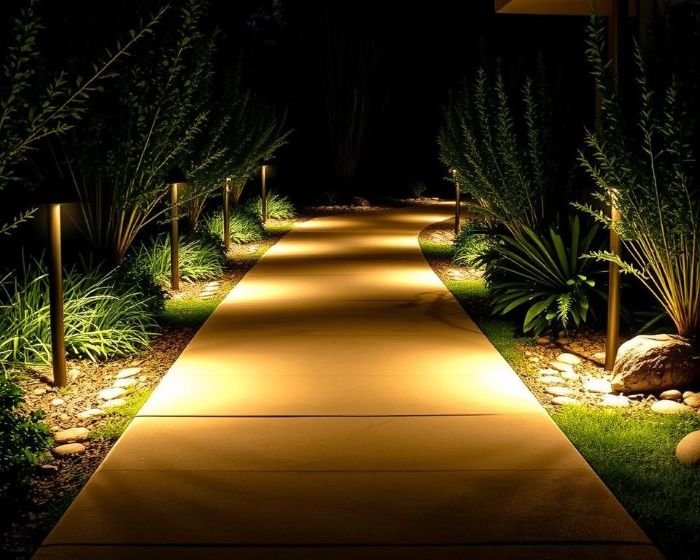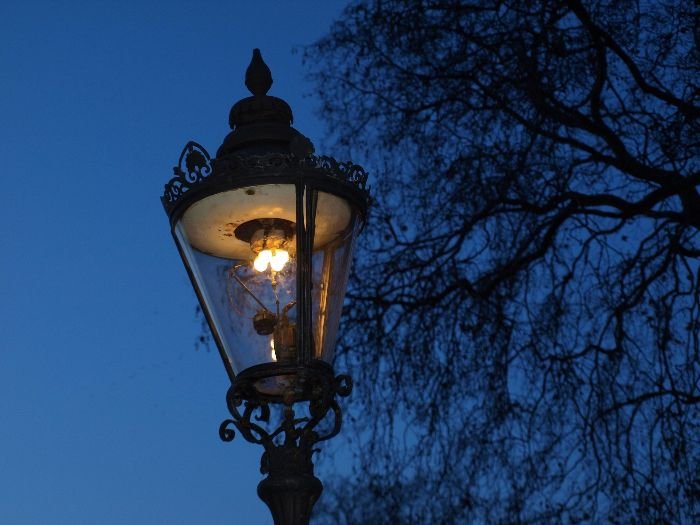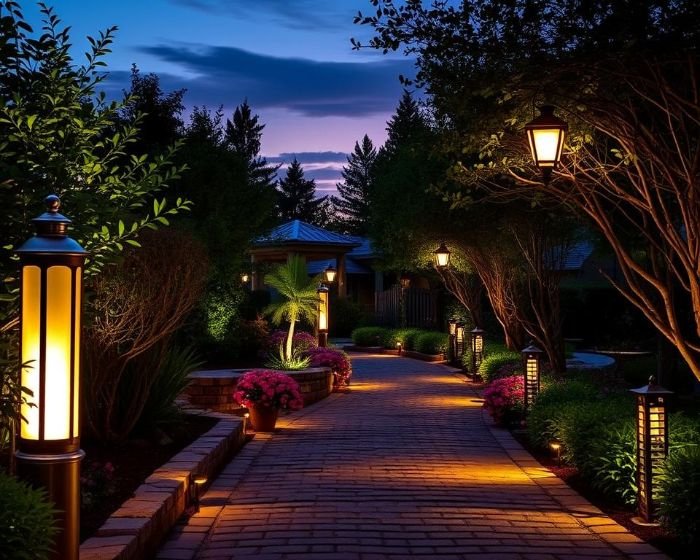Ever thought about how pathway lighting can change your outdoor space? It’s not just about looks. It also makes your garden safer and more welcoming. This guide will show you how to light up your path safely and stylishly.
Key Takeaways
- Pathway lighting is essential for both safety and aesthetics.
- Effective design requires strategic planning and consideration of key areas.
- Choosing the right fixtures and power sources impacts both functionality and style.
- Light placement is critical for optimal illumination and minimizing glare.
- Incorporating different light colors and intensities can enhance ambiance.
- Regular maintenance is vital to keep your lighting system performing at its best.
Table of Contents
Why Pathway Lighting is Essential for Garden Design
Pathway lighting is key in garden design, complementing creative walkway planning to enhance both aesthetics and safety. It’s both useful and beautiful. The right lights make your garden more inviting and safe.
Enhancing Safety and Navigation
Good pathway lighting makes your garden safer. It lights up dark spots, preventing falls. This lets people walk safely at night, perfect for evening walks.
Adding Aesthetic Appeal and Defining Spaces
Pathway lighting also makes your garden look better. It shows off your garden’s best parts. Well-placed lights make your garden feel welcoming and clear.
Planning Your Pathway Lighting Design
Good pathway lighting planning starts with a detailed look at your garden. It’s important to pick out key areas to highlight. This lets homeowners show off their outdoor spaces’ best features.
Knowing why you need pathway lighting is key. Is it for walking, safety, or setting a mood? This helps shape your design plan and aligns with the fundamentals of effective garden lighting.
Assessing the Layout and Key Areas to Highlight
Your garden has special features that need the right light. Start by looking closely at:
- Walkways and steps that need to be seen clearly
- Garden beds and special points that add interest
- Landscaping like trees and shrubs that add texture
Doing a detailed layout check helps pick the best lights and where to put them. This boosts both safety and looks.
Determining the Purpose – Functionality vs. Ambiance
Understanding why you need pathway lighting is crucial. Think about these goals:
- Functionality – For safety, choose bright lights for clear path visibility.
- Ambiance – For a cozy feel, pick softer, warm lights that invite.
Knowing what you want most affects your lighting design. With careful thought, you can mix usefulness with beauty.
Choosing the Right Lighting Fixtures for Pathways
Understanding the types of pathway lights is key for good lighting. The right lights make paths safe and look great in gardens or outdoor areas.
Path Lights, Bollard Lights, and Inground Lights
There are many pathway lighting options. Each has its own special features:
- Path Lights – These are often seen on sidewalks and driveways. They give a soft light that helps guide people.
- Bollard Lights – These tall lights are made to last outside. They look modern and light up big areas well.
- Inground Lights – These lights are set into the ground. They cause little glare and can make landscaping pop.
Solar vs. Low-Voltage – Selecting the Best Power Source
Choosing between solar and low-voltage lights is crucial. Solar lights, which harness sunlight, are easy to set up; for more details on eco-friendly illumination methods, explore solar garden lighting solutions. But, they might not be as bright as low-voltage lights.
Low-voltage lights need wiring but are brighter and more flexible. They work well with LED bulbs, saving energy and lasting long.
Designing with Light Placement and Spacing
Good design means thinking about where to put lights and how far apart they should be. This makes paths both safe and pretty. It makes us want to enjoy the outdoors more, no matter the weather.
Proper Spacing for Balanced Illumination
Keep lights 6 to 10 feet apart for the best light. This avoids a messy look and makes sure paths are well-lit. Think about your garden’s size and design to figure out how many lights you need.
Tips for Positioning Lights to Minimize Glare
Focus on placing lights to cut down glare. Downlighting is great for this. It shines light down, making paths bright without harsh reflections.
Adding shades can also help. They soften the light, making it more comfortable to walk around.

Creating Ambiance with Light Color and Intensity
Light color effects are key to making outdoor spaces feel right. Warm lights make areas cozy and inviting. Cool lights, on the other hand, bring a modern vibe. Choosing the right light color is crucial for the mood you want.
Warm vs. Cool Light – Setting the Mood
Think about how light colors change how we feel. Here are some important points:
- Warm Lights – Great for a cozy, relaxing vibe. Perfect for garden parties.
- Cool Lights – Best for modern looks and lively feels. Highlights gardens and buildings well.
Dimming Options for Adjustable Lighting
Adjusting light intensity lets you change your pathway’s look. Dimming options let you adjust brightness for different times or moods. This makes your space more versatile and mood-friendly, especially if you consider smart lighting controls that let you set different scenes for various occasions. Some benefits include:
- More comfort during evening gatherings.
- Less energy use when you don’t need full brightness.
- Easy changes to match any situation.
Enhancing Pathways with Creative Lighting Techniques
Creative pathway lighting makes outdoor spaces look amazing; illuminating garden paths effectively can transform a simple walkway into a captivating focal point. It uses new lighting ways to make spaces look good and work well.
Using Shadows and Light Patterns for Visual Interest
Shadows and light patterns make designs more interesting. Lights placed right can show off textures of plants and stones. This mix of light and dark adds depth and makes paths more appealing.
Try using lights that let you change how they shine. This way, you can make cool shadow patterns that change as night falls.
Layering Lights for Depth and Dimension
Using different lights adds depth to pathways. You can mix ambient, task, and accent lights for a balanced look. Ambient lights give a general glow, task lights focus on specific spots, and accent lights highlight special features.
Installation Tips for a Professional Finish
Proper pathway lighting installation makes your landscape bright and safe. It also makes your lights last longer. Paying close attention to details is key.
Safely Installing Fixtures and Concealing Cables
When adding outdoor lighting, safety comes first. Start by picking lights made for the outdoors. Here’s how to install them right:
- Choose the best spots for your lights. Make sure they light up the path well.
- Use wire connectors and staples to keep cables tidy.
- Make sure buried cables are at least 6 inches underground to avoid damage.
Weatherproofing and Protecting Your Lighting Setup
Keeping your outdoor lights dry is crucial. They should work well all year. Here’s how to keep them safe:
- Choose materials like stainless steel or high-quality plastic for your lights.
- Apply silicone sealant around the lights to keep moisture out.
- Check seals and connections often. Replace them if they show wear.
Maintenance Tips to Keep Your Pathway Lighting Bright
Keeping your outdoor spaces bright is key. Regular cleaning and adjustments make them look better and work better. This section will give you important tips for cleaning and fixing pathway lights.
Regular Cleaning and Adjustments for Optimal Performance
Keep your pathway lights bright by cleaning them often. Dust and dirt can block the light. Here are some cleaning tips:
- Wipe down fixtures with a soft cloth and mild soap solution.
- Remove any foliage obstructing light paths.
- Inspect and adjust the angles of fixtures to ensure proper illumination.
Changing bulb intensity or moving lights can help a lot. Make sure nothing blocks the light for better performance.
Troubleshooting Common Issues with Pathway Lights
Check for common problems often to avoid big repairs. Here are some tips for fixing pathway lights:
- Check if bulbs need replacing. Regularly inspect bulbs for signs of burnout.
- Examine the circuit connections. Loose wiring can cause lights to malfunction.
- Inspect for water accumulation in fixtures, which may cause electrical issues.
Fixing these problems quickly keeps your lights working well all year.

Conclusion
Pathway lighting design is key to making outdoor spaces better. It mixes beauty with safety, making gardens more inviting at night. By following this guide, you can make your landscape look great and safe.
Choosing the right lights and placing them well is important. Color and brightness also matter a lot. Good lighting makes your outdoor areas safe and welcoming for everyone.
Good lighting makes your outdoor spaces better and safer. It lets you enjoy your garden more at night. Invest in quality lighting to make your home look better and feel more welcoming.
FAQ
What is the primary purpose of pathway lighting design?
Pathway lighting makes walkways safer and easier to navigate at night. It also helps avoid tripping hazards. Plus, it adds beauty, showing off your garden and home.
How do I assess my garden layout for pathway lighting?
First, think about the areas and features you want to highlight. This could be flowerbeds or statues. Then, decide if you want to focus on safety or creating a welcoming feel.
What types of lighting fixtures are best for pathways?
Path lights, bollard lights, and inground lights are popular choices. They come in different heights and brightness levels. This lets you create a unique lighting plan for your outdoor space.
Should I choose solar power or a low-voltage wired system for my pathway lighting?
Solar lights are easy to set up and don’t need wiring. But, wired systems are more reliable and brighter. LED lights are best for their long life and good performance.
How far apart should I space my pathway lights?
Space lights 6 to 10 feet apart for even lighting. This ensures your walkway is well-lit without looking too busy.
What color temperature should I choose for my pathway lighting?
Warm lights create a cozy feel, while cool lights are modern. Dimming options can make your lighting more versatile.
How can I enhance my pathway lighting with creative techniques?
Mix different lighting types for interesting effects. Use shadows and light to add depth. Adding ambient, task, and accent lighting makes your outdoor space more engaging.
What are essential tips for safely installing pathway lights?
Make sure lights are installed securely and cables are hidden. Protecting your lights from the weather keeps them working well for longer.
Why is maintenance important for pathway lighting?
Keeping lights clean ensures they work well. Regular checks and fixing problems, like changing bulbs, are key to their long-term use.










